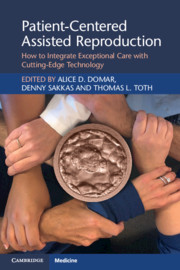 Patient-Centered Assisted Reproduction
Patient-Centered Assisted Reproduction Book contents
- Patient-Centered Assisted Reproduction
- Patient-Centered Assisted Reproduction
- Copyright page
- Contents
- Contributors
- Introduction
- Chapter 1 Access to Infertility Care
- Chapter 2 The Patient Evaluation of the Future: Genetics, New Diagnostics, and Prediction Modeling
- Chapter 3 Advances in ART Pharmacology: Drug Delivery Systems and the Pipeline
- Chapter 4 ART Monitoring: An End to Frequent Clinic Visits and Needle Sticks?
- Chapter 5 The IVF Cycle to Come: Laboratory Innovations
- Chapter 6 Integrative Care
- Chapter 7 Psychological Counseling: Ethical Challenges of the Future
- Chapter 8 Using Technology to Enhance Communication in Medically Assisted Reproductive Care
- Chapter 9 The Economics of IVF: Evaluating the Necessity and Value of Public Funding
- Chapter 10 Medical and Elective Fertility Preservation: Options and Suggestions for a Patient-Centered Approach
- Chapter 11 Patient Retention, Nursing Retention: The Importance of Empathic Communication and Nursing Support
- Chapter 12 Patient-Centered IVF Care
- Chapter 13 The IVF Patient Journey of the Future
- Index
- References
Chapter 2 - The Patient Evaluation of the Future: Genetics, New Diagnostics, and Prediction Modeling
Published online by Cambridge University Press: 02 March 2020
- Patient-Centered Assisted Reproduction
- Patient-Centered Assisted Reproduction
- Copyright page
- Contents
- Contributors
- Introduction
- Chapter 1 Access to Infertility Care
- Chapter 2 The Patient Evaluation of the Future: Genetics, New Diagnostics, and Prediction Modeling
- Chapter 3 Advances in ART Pharmacology: Drug Delivery Systems and the Pipeline
- Chapter 4 ART Monitoring: An End to Frequent Clinic Visits and Needle Sticks?
- Chapter 5 The IVF Cycle to Come: Laboratory Innovations
- Chapter 6 Integrative Care
- Chapter 7 Psychological Counseling: Ethical Challenges of the Future
- Chapter 8 Using Technology to Enhance Communication in Medically Assisted Reproductive Care
- Chapter 9 The Economics of IVF: Evaluating the Necessity and Value of Public Funding
- Chapter 10 Medical and Elective Fertility Preservation: Options and Suggestions for a Patient-Centered Approach
- Chapter 11 Patient Retention, Nursing Retention: The Importance of Empathic Communication and Nursing Support
- Chapter 12 Patient-Centered IVF Care
- Chapter 13 The IVF Patient Journey of the Future
- Index
- References
Summary
Genetic risk is defined as the probability of a person (or couple) conceiving a pregnancy with genetic mutations or chromosomal abnormalities that would lead to a severe pathological condition. Genetic mutations are concealed in the genome of almost every person. Most of these mutations are harmless in single copy, but if present in homozygosis, they can lead to severe clinical outcomes. Often, couples carrying unidentified genetic mutations become aware of their dangerous mutations only after conception of an affected child.
- Type
- Chapter
- Information
- Patient-Centered Assisted ReproductionHow to Integrate Exceptional Care with Cutting-Edge Technology, pp. 11 - 22Publisher: Cambridge University PressPrint publication year: 2020
